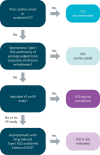Brugada syndrome: a review of the literature
- PMID: 25301907
- PMCID: PMC4951955
- DOI: 10.7861/clinmedicine.14-5-482
Brugada syndrome: a review of the literature
Abstract
Brugada syndrome is an example of a channelopathy caused by an alteration in the transmembrane ion currents that together constitute the cardiac action potential. Approximately 20% of the cases of Brugada syndrome have been shown to be associated with mutations in the gene coding for the sodium ion channel in the cell membranes of the muscle cells of the heart. Patients with Brugada syndrome are prone to develop ventricular tachyarrhythmias that may lead to syncope, cardiac arrest or sudden cardiac death. Many clinical situations have been reported to unmask or exacerbate the electrocardiography (ECG) pattern of Brugada syndrome. Genetic testing for Brugada syndrome is clinically available. Here we report two cases of Brugada syndrome followed by a comprehensive review of the literature.
Keywords: Brugada syndrome; atrial fibrillation; channelopathy; sudden cardiac death; syncope.
© 2014 Royal College of Physicians.
Figures




Comment in
-
Brugada phenocopies are the leading differential diagnosis of Brugada syndrome.Clin Med (Lond). 2015 Jun;15(3):308-9. doi: 10.7861/clinmedicine.15-3-308. Clin Med (Lond). 2015. PMID: 26031989 Free PMC article.
References
-
- Tohyou Y, Nakazawa K, Ozawa A, et al. A survey in the incidence of right bundle branch block with ST segment elevation among normal population. Jpn J Electrocardiology 1995;15:223–6.10.5105/jse.15.223 - DOI
Publication types
MeSH terms
LinkOut - more resources
Full Text Sources
Other Literature Sources

